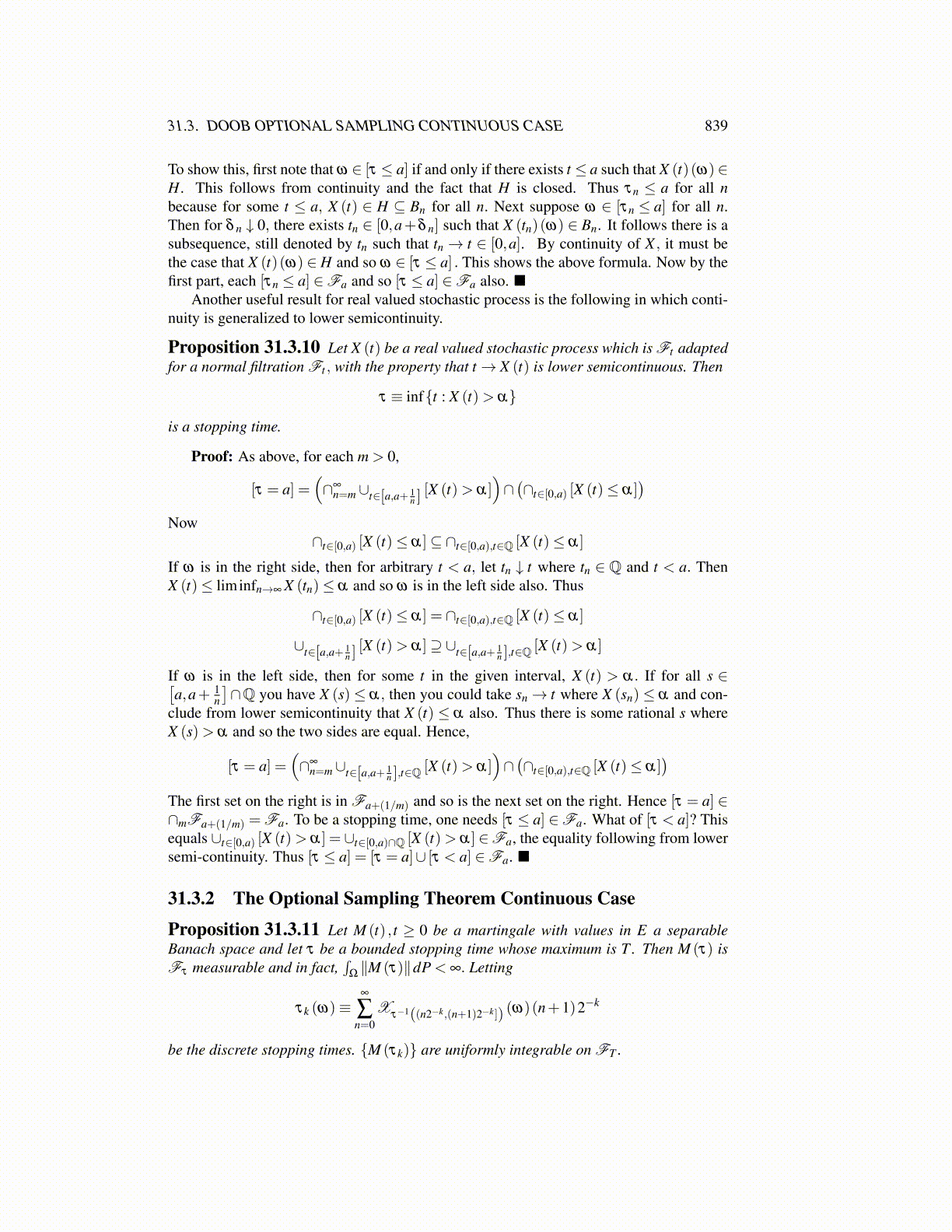
31.3. DOOB OPTIONAL SAMPLING CONTINUOUS CASE 839
To show this, first note that ω ∈ [τ ≤ a] if and only if there exists t ≤ a such that X (t)(ω)∈H. This follows from continuity and the fact that H is closed. Thus τn ≤ a for all nbecause for some t ≤ a, X (t) ∈ H ⊆ Bn for all n. Next suppose ω ∈ [τn ≤ a] for all n.Then for δ n ↓ 0, there exists tn ∈ [0,a+δ n] such that X (tn)(ω) ∈ Bn. It follows there is asubsequence, still denoted by tn such that tn → t ∈ [0,a]. By continuity of X , it must bethe case that X (t)(ω) ∈H and so ω ∈ [τ ≤ a] . This shows the above formula. Now by thefirst part, each [τn ≤ a] ∈Fa and so [τ ≤ a] ∈Fa also. ■
Another useful result for real valued stochastic process is the following in which conti-nuity is generalized to lower semicontinuity.
Proposition 31.3.10 Let X (t) be a real valued stochastic process which is Ft adaptedfor a normal filtration Ft , with the property that t→ X (t) is lower semicontinuous. Then
τ ≡ inf{t : X (t)> α}
is a stopping time.
Proof: As above, for each m > 0,
[τ = a] =(∩∞
n=m∪t∈[a,a+ 1n ][X (t)> α]
)∩(∩t∈[0,a) [X (t)≤ α]
)Now
∩t∈[0,a) [X (t)≤ α]⊆ ∩t∈[0,a),t∈Q [X (t)≤ α]
If ω is in the right side, then for arbitrary t < a, let tn ↓ t where tn ∈ Q and t < a. ThenX (t)≤ liminfn→∞ X (tn)≤ α and so ω is in the left side also. Thus
∩t∈[0,a) [X (t)≤ α] = ∩t∈[0,a),t∈Q [X (t)≤ α]
∪t∈[a,a+ 1n ][X (t)> α]⊇ ∪t∈[a,a+ 1
n ],t∈Q[X (t)> α]
If ω is in the left side, then for some t in the given interval, X (t) > α. If for all s ∈[a,a+ 1
n
]∩Q you have X (s)≤ α, then you could take sn→ t where X (sn)≤ α and con-
clude from lower semicontinuity that X (t) ≤ α also. Thus there is some rational s whereX (s)> α and so the two sides are equal. Hence,
[τ = a] =(∩∞
n=m∪t∈[a,a+ 1n ],t∈Q
[X (t)> α])∩(∩t∈[0,a),t∈Q [X (t)≤ α]
)The first set on the right is in Fa+(1/m) and so is the next set on the right. Hence [τ = a] ∈∩mFa+(1/m) = Fa. To be a stopping time, one needs [τ ≤ a] ∈Fa. What of [τ < a]? Thisequals ∪t∈[0,a) [X (t)> α] = ∪t∈[0,a)∩Q [X (t)> α] ∈Fa, the equality following from lowersemi-continuity. Thus [τ ≤ a] = [τ = a]∪ [τ < a] ∈Fa. ■
31.3.2 The Optional Sampling Theorem Continuous Case
Proposition 31.3.11 Let M (t) , t ≥ 0 be a martingale with values in E a separableBanach space and let τ be a bounded stopping time whose maximum is T . Then M (τ) isFτ measurable and in fact,
∫Ω∥M (τ)∥dP < ∞. Letting
τk (ω)≡∞
∑n=0
Xτ−1((n2−k,(n+1)2−k]) (ω)(n+1)2−k
be the discrete stopping times. {M (τk)} are uniformly integrable on FT .